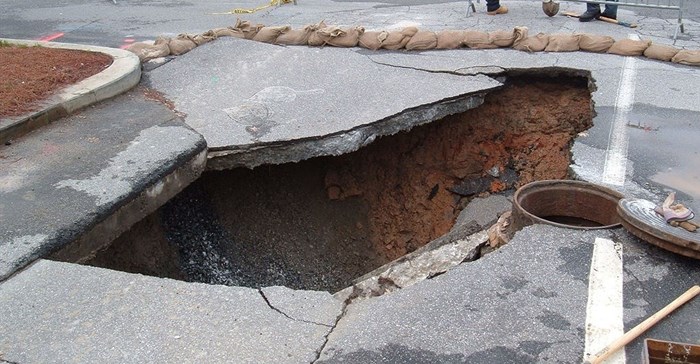
The sinkhole was discovered when the CSIR processed historical satellite imagery over the greater Tshwane area and also started with new image acquisitions that will be on-going for the foreseeable future.
"Our analysis indicated that surface subsidence was taking place at an unpopulated site in Centurion. The subsidence was detected with a total of 6.6cm of deformation recorded between June and August 2015. The deformation features was about 100 meter in diameter," says CSIR's senior researcher in Synthetic Aperture Radar, Dr Jeanine Engelbrecht.
After being granted access to the property in December 2015 to investigate if any signs of deformation were visible at the surface, the CSIR scientists found that indeed a sinkhole had formed.
"The water supply pipe was leaking and, initially, the sinkhole was about 0.5 by 1 metre in extent. However, later on the same morning, the pipe burst spectacularly, and resulted in a continuous jet of water spraying from the ground. We also observed tension cracks of tens of metres long surrounding the deformation feature," Engelbrecht says.
"We postulate that the pipe may have been leaking for some time, resulting in a cavity in the dolomite. This process also caused the small-scale deformation features that we were able to detect on the satellite imagery. When the sinkhole started to form on the morning of 17 December, the stress on the pipe infrastructure increased to such an extent, that the pipe ruptured, causing the jets of water observed," she adds.
In South Africa, extensive areas are underlain by dolomitic rock which is known to be associated with sudden, catastrophic collapse, also known as sinkholes. Over 3,000 sinkhole and subsidence events have been recorded in South Africa between the early 1960's and the end of 2012. The consequences of sinkhole formation are severe and have resulted in the deaths of at least 39 people over the past 50 years in South Africa.
Although sinkholes occur with little warning, the appearance of tension cracks and surface subsidence are often early warning signs of impending sinkhole formation. The risks associated with sinkhole hazards suggest that the development of a technique to detect and measure precursory deformation before the sudden collapse would be invaluable.
"This is a great validation of the technology and it proves that satellite imaging technology can be used to detect small-scale surface deformation before sinkhole development. A lot of additional work will need to be performed to test the operational limitations of the technique. However, the results prove that a sinkhole early-warning system may be on the cards in the near future," concludes Engelbrecht.